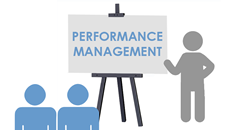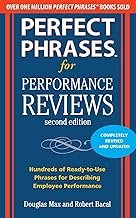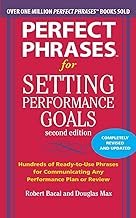Preface - Performance Management - A Briefcase Book By Robert Bacal
As you hold this book in your hands, somewhere a manager and an employee
are meeting to discuss the employee's performance-a performance appraisal
meeting if you will. Chances are the manager would rather be doing something
else. Odds are the employee would rather be having multiple root canal
surgery without anesthetic. What's more, for every manager who's sitting
down with an employee to evaluate performance, there's a manager who's
trying to figure out how to avoid doing it-to avoid filling out the forms,
having the meeting, communicating about performance.
OK, so most people really don't like performance appraisals. Should we
care? Should you care? Probably. We know that communication between manager
and employee about performance is essential to increase productivity,
improve staff morale and motivation, and allow coordination of each employee's
work so it contributes to the goals of the company.
But many managers focus on the wrong things. They focus on appraisal rather
than planning. They focus on a one-way flow of words (manager to employee),
rather than dialogue. They focus on required forms rather than the communication
needed for everyone to succeed. They focus on the past rather than the
present and future. They focus on blaming rather than solving problems.
As a result, what should be a cooperative effort between manager and employee,
working together as a team, turns into an awkward, stressful process both
parties try to avoid. Or into a meaningless paper chase that wastes time
and energy.
It doesn't have to be that way. While many companies and managers simply
aren't getting much value from the time they spend in performance management
and appraisal, there are people out there who are reaping benefits from
the process. How are they doing it? How are they making it work?
That's what this book is about. It's about reorienting ourselves-focusing
on what organizations, managers, and employees need to succeed. It's about
looking at performance appraisal and performance management as ways to
engineer success for everyone. It's about understanding that performance
management is a people process. It's about helping you learn how to communicate
cooperatively with staff to improve performance.
This book is not about theory. It's about doing all the things that make
performance management work.
Why Read This Book?
Chances are you aren't getting full value from whatever you're doing
to manage performance. That's why I wrote this book.
First, we help you focus on why you need to manage performance. What do
you gain as a manager? How do employees benefit? How does your company
gain? Second, we help you figure out how to do it so it works. You'll
learn the steps in the performance communication/management process. You'll
learn how to turn it into a true dialogue. You'll learn how to turn even
badly designed forms and procedures into something useful. And perhaps
most important, you'll learn how to reduce the discomfort most people
associate with performance management and performance appraisal.
Overview
The first three chapters in this book will help you understand where
performance management fits into the broader scheme of things and the
benefits of doing it well.
Chapter 1 presents an overview of the process, defines it, and explains
the payoffs for managers, employees, and the organization.
In Chapter 2 we tackle some of the challenges of performance management.
You'll find out why so many people try to avoid it. You'll also find out
what makes a performance management system work-and the consequences of
systems that don't work.
Chapter 3 discusses performance management as a system in which all of
the parts must work together. We'll also relate performance management
to other things in your company-to strategic planning, to discipline,
and to training and employee development.
Once we've set the stage, we move on to doing it and doing it right.
Chapter 4 helps you prepare yourself and your employees for the performance
management process. You need information to make it work. What information?
I'll tell you. How do you prepare staff to work with you? I'll help you
with that, too.
Chapter 5 deals with what may be the most important part of performance
management-performance planning. You and each employee must determine
what he or she is to accomplish, identify the bull's-eyes the employee
will be trying to hit. You work together so you come to a common understanding.
Chapter 6 talks about ongoing performance communication. You cannot simply
set performance targets and then wait until it's time for appraisals.
That approach is deadly and guarantees failure. We'll present some options
for formal and informal ways to communicate about employee performance
during the year.
In Chapter 7 you'll find a process for gathering data, observing, and
documenting. Performance management and appraisal should be based on more
than just opinions. It should be based on facts and observations. I also
talk about the need to document and to communicate about performance,
so both you and the company have some protection from malicious or unfair
legal action.
In Chapters 8 and 9 we consider the performance appraisal and review process.
You'll find a discussion of the merits and pitfalls associated with rating
systems, ranking systems, and objective-based systems. I'll help you understand
how you can conduct the performance review meeting so it's cooperative
and so you and the employee are on the same side.
There's hardly any point in managing performance unless you work toward
improving it. What's done is done. We need to look to the future and work
with employees so they can get better and better. Chapter 10 talks about
the performance diagnosis and improvement process. How do you identify
the causes of performance difficulties? Where do you look? And how do
you remove barriers to performance?
Sometimes managers need to take action with respect to employees who are
consistently not meeting expectations. While performance management isn't
used primarily for disciplinary reasons, it does play an important role
in dealing with serious workplace problems and difficulties. In Chapter
11 we'll talk about progressive disciplinary actions and how to deal with
those tough situations.
Chapters 12 and 13 talk about some interesting alternatives and variations
in performance management. You'll find information on 360-degree feedback
techniques and other innovative approaches. We'll also answer the most
common questions managers have about the performance management process.
Chapter 14 returns us to the central theme-that performance management
is about creating relationships and ensuring effective communication.
It isn't about forms or judging or categorizing employees. It's about
people. In this chapter we'll talk about specific skills and things you
can do to make it work.
Finally, in Chapter 15, we'll pull it all together with a case study.
You'll read about Acme Progressive and how the company used a performance
management system so everyone gained.
We don't believe that it's possible to use a cookbook approach to performance management. There isn't one recipe that will work for everyone. It is possible, though, to provide the principles and actions associated with successful performance management so you can make it work for your staff and your company. By the end of this book, you will have a good grasp of the whys, hows, whens, and whats of performance management so you can develop a way of doing it that helps everyone-you, your staff, and your organization.
Special Features
The idea behind the books in the Briefcase Series is to give you practical
information written in a friendly person-to-person style. The chapters
are short, deal with tactical issues, and include lots of examples. They
also feature numerous boxes designed to give you different types of specific
information.
For more information on this book, please click here




